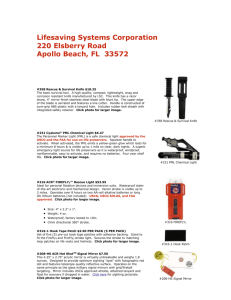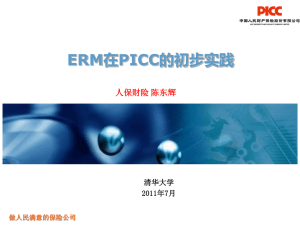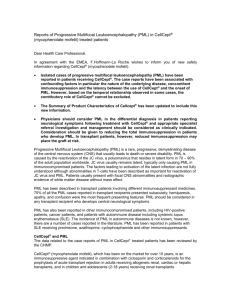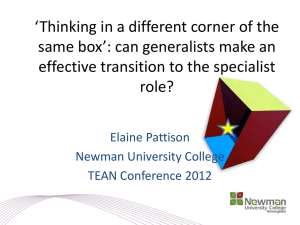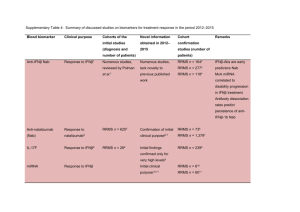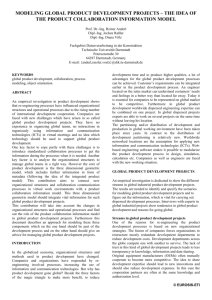Perfectly matched layer for acoustic waveguide modeling
advertisement
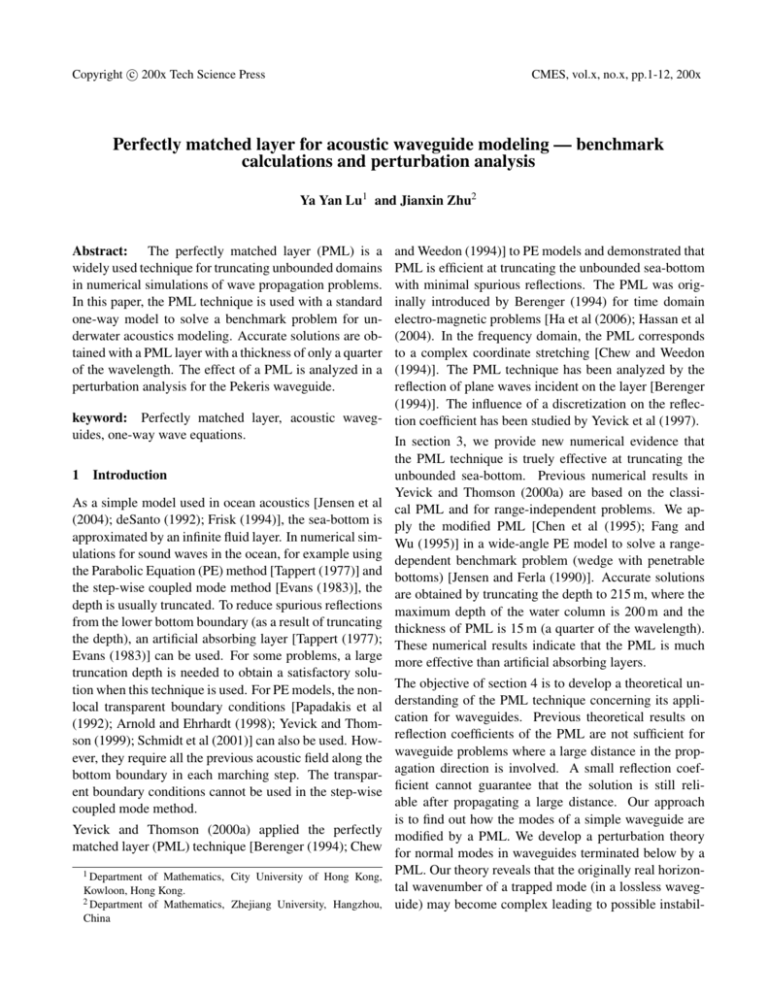
c 200x Tech Science Press Copyright CMES, vol.x, no.x, pp.1-12, 200x Perfectly matched layer for acoustic waveguide modeling — benchmark calculations and perturbation analysis Ya Yan Lu1 and Jianxin Zhu2 Abstract: The perfectly matched layer (PML) is a widely used technique for truncating unbounded domains in numerical simulations of wave propagation problems. In this paper, the PML technique is used with a standard one-way model to solve a benchmark problem for underwater acoustics modeling. Accurate solutions are obtained with a PML layer with a thickness of only a quarter of the wavelength. The effect of a PML is analyzed in a perturbation analysis for the Pekeris waveguide. and Weedon (1994)] to PE models and demonstrated that PML is efficient at truncating the unbounded sea-bottom with minimal spurious reflections. The PML was originally introduced by Berenger (1994) for time domain electro-magnetic problems [Ha et al (2006); Hassan et al (2004). In the frequency domain, the PML corresponds to a complex coordinate stretching [Chew and Weedon (1994)]. The PML technique has been analyzed by the reflection of plane waves incident on the layer [Berenger (1994)]. The influence of a discretization on the refleckeyword: Perfectly matched layer, acoustic waveg- tion coefficient has been studied by Yevick et al (1997). uides, one-way wave equations. In section 3, we provide new numerical evidence that 1 Introduction As a simple model used in ocean acoustics [Jensen et al (2004); deSanto (1992); Frisk (1994)], the sea-bottom is approximated by an infinite fluid layer. In numerical simulations for sound waves in the ocean, for example using the Parabolic Equation (PE) method [Tappert (1977)] and the step-wise coupled mode method [Evans (1983)], the depth is usually truncated. To reduce spurious reflections from the lower bottom boundary (as a result of truncating the depth), an artificial absorbing layer [Tappert (1977); Evans (1983)] can be used. For some problems, a large truncation depth is needed to obtain a satisfactory solution when this technique is used. For PE models, the nonlocal transparent boundary conditions [Papadakis et al (1992); Arnold and Ehrhardt (1998); Yevick and Thomson (1999); Schmidt et al (2001)] can also be used. However, they require all the previous acoustic field along the bottom boundary in each marching step. The transparent boundary conditions cannot be used in the step-wise coupled mode method. Yevick and Thomson (2000a) applied the perfectly matched layer (PML) technique [Berenger (1994); Chew 1 Department of Mathematics, City University of Hong Kong, Kowloon, Hong Kong. 2 Department of Mathematics, Zhejiang University, Hangzhou, China the PML technique is truely effective at truncating the unbounded sea-bottom. Previous numerical results in Yevick and Thomson (2000a) are based on the classical PML and for range-independent problems. We apply the modified PML [Chen et al (1995); Fang and Wu (1995)] in a wide-angle PE model to solve a rangedependent benchmark problem (wedge with penetrable bottoms) [Jensen and Ferla (1990)]. Accurate solutions are obtained by truncating the depth to 215 m, where the maximum depth of the water column is 200 m and the thickness of PML is 15 m (a quarter of the wavelength). These numerical results indicate that the PML is much more effective than artificial absorbing layers. The objective of section 4 is to develop a theoretical understanding of the PML technique concerning its application for waveguides. Previous theoretical results on reflection coefficients of the PML are not sufficient for waveguide problems where a large distance in the propagation direction is involved. A small reflection coefficient cannot guarantee that the solution is still reliable after propagating a large distance. Our approach is to find out how the modes of a simple waveguide are modified by a PML. We develop a perturbation theory for normal modes in waveguides terminated below by a PML. Our theory reveals that the originally real horizontal wavenumber of a trapped mode (in a lossless waveguide) may become complex leading to possible instabil- 2 c 200x Tech Science Press Copyright CMES, vol.x, no.x, pp.1-12, 200x ity or non-physical attenuation of the mode. Therefore, z = H, the density and wavenumber are constants and the the PML parameters must be chosen carefully if the total Helmholtz equation is simplified to uxx + uzz + k22 u = 0. propagation distance is large. For G < z < H, we consider a down-going (towards z = +∞) plane wave solution 2 The PML and its reflection coefficient u(d) = ei(αx+βz) , We consider the two dimensional Helmholtz equation: where β > 0 and α2 +β2 = k22 . For the original Helmholtz ∂ 1 ∂u ∂ 1 ∂u +ρ + k2 u = 0, (1) equation (1), the above solution is extended to z > H ρ ∂x ρ ∂x ∂z ρ ∂z without any reflections. For the modified equation (3), (d) where x is the horizontal distance (called range in ocean the incident wave u above is connected to acoustics), z is the depth, ρ is the density and k is the wavenumber. Both ρ and k are functions of x and z. For ocean acoustics, the pressure-release condition u = 0 is typically used at z = 0. If the ocean bottom is modeled by an infinite fluid layer, equation (1) is valid for the half plane z > 0. To use the PML, we need to assume that the medium is homogeneous for a sufficiently large depth. That is, we have some G, such that ρ = ρ2 and k = k2 for z > G, where ρ2 and k2 are constants. u(d) = ei(αx+βẑ) = ei(αx+βz) e−β Rz 0 σ(τ)dτ for z > H. With σ(z) > 0 for z > H, if 0z σ(τ)dτ → ∞ as z → ∞, then u(d) (x, z) → 0 as z → ∞. Therefore, the radiation condition for the Helmholtz equation is equivalent to the condition lim u = 0 (6) R z→∞ for the modified equation (3). In practice, the PML has The PML corresponds to changing the depth z to the a finite thickness and a boundary condition is imposed at z = D. If the zero Dirichlet condition (4) is used, we have complex variable ẑ [Chew and Weedon (1994)]: the following solution of (3): Z z ẑ = z + i σ(τ) dτ (2) 0 where σ(z) = 0 for 0 < z ≤ H, σ(z) > 0 for z > H and H ≥ G. If we replace ∂z in (1) by ∂ẑ = [1 + iσ(z)]∂z, we obtain the following modified Helmholtz equation: ∂u ∂ 1 ∂u ρ ∂ 1 ρ + + k2 u = 0. ∂x ρ ∂x 1 + iσ ∂z ρ(1 + iσ) ∂z (3) Notice that (1) and (3) are different only if z > H. For numerical computations, it is necessary to truncate the variable z to a finite interval, say 0 < z < D, where D > H. The interval (H, D) is then the actual PML layer. Equation (3) is solved with a suitable boundary condition at z = D. In the simplest case, we let u=0 at z = D. (4) Alternatively, we can assume uz = a u at z = D (5) for some constant a. Standard analysis [Berenger (1994)] of the PML is concerned with the reflection of a down-going plane wave incident upon the interface at z = H. In the vicinity of u = u(d) + u(u) = ei(αx+βẑ) + Rei(αx−βẑ) where R = −e2iβD e−2β RD RD H σ(τ)dτ for z > H, . the reflection Notice that |R| = exp(−2β H σ(τ)dτ), thus R coefficient is exponentially small with HD σ(τ)dτ, but it also depends the angle of incidence. Let θ be the angle between the z axis and the wave vector (α, β), we have β = k2 cos(θ). Therefore, the reflection coefficient is smallest for pure down-going waves (θ = 0). When θ is close to ±π/2, β is small and the reflection coefficient is relatively large. One observation is that |R| depends R on the integral HD σ(τ)dτ, rather than on |H − D|. Therefore, if a larger σ is used, the thickness of the PML can be reduced while keeping the magnitude of the reflection coefficient unchanged. In reality, when the z variable is discretized in a numerical scheme, the truncation error may be dominant. Therefore, |H − D| cannot be too small. A study of the reflection coefficient including the effect of discretizing z can be found in Yevick et al (1997). Furthermore, when the Helmholtz equation is solved with some numerical method, it is natural to require that the reflection coefficient is as small as the errors introduced in the discretization of the domain. For example, when a 3 Perfectly matched layer for acoustic waveguide modeling second order finite difference method is used, we could require that r=0 r 4km z=0 −k2 cos(θ∗ ) e RD H σ(τ)dτ ∼ ∆z λ 2 water , f=25Hz sea−bottom where λ = 2π/k2 is the wavelength in the homogeneous 200m sea-bottom, ∆z is the grid size in z and θ∗ is the maxiz mum angle of incidence for which an accurate solution is needed. Figure 1 : Benchmark wedge problem with a penetrable The above reflection coefficient analysis is actually in- sea-bottom. complete, since waves that decay in the positive z direction are not considered. For a range-independent waveguide (i.e, ρ and k are independent of x), we have the range-independent problems. In this section, we contrapped modes given in the form sider a range-dependent benchmark problem — wedge (d) iαx−γ(z−H) with a penetrable bottom [Jensen and Ferla (1990)]. As u =e shown in Fig. 1, the problem is concerned with a ho2 2 2 for z > G, where γ > 0 and α − γ = k2 . The solution mogeneous water column (sound speed c = 1500 m/s, 3 decays exponentially in the positive z direction. With the density ρ = 1 g/cm ) above a homogeneous sea-bottom 3 transform z → ẑ, the solution still decays exponentially in (c = 1700 m/s, ρ = 1.5 g/cm ), the water-bottom interz and it is consistent with condition (6). When the PML face is a linear function of the radial variable r which is truncated at z = D with the boundary condition (4), the has a maximum of 200 m at r = 0 and it reaches zero at r = 4000 m. A point source of frequency f = 25 Hz is solution of (3) for z > H is now given by located at r = 0 and z = 100 m. u = u(d) + u(u) = eiαx−γ(ẑ−H) + Reiαx+γ(ẑ−H) For this problem, the maximum depth of the water colfor R = −e−2γ(D−H+i RD H σ(τ)dτ) . Here, we have defined the reflection coefficient relative to the solution at z = H, therefore, H is involved in the formula of R. Since |R| = e−2γ(D−H) , we can see that the magnitude of the reflection coefficient is independent of σ. In order to reduce the reflection, we could increase D. Alternatively [Chen et al (1995); Fang and Wu (1995)], we can include a new term in the real part of ẑ: Z z ẑ = z + [γ(τ) + iσ(τ)] dτ, (7) 0 where γ(z) = 0 for z ≤ H and γ(z) > 0 for z > H. In this case, the formula of R can be easily obtained by replacing σ with σ − iγ. 3 Application of PML to a benchmark problem Yevick and Thomson (2000a) applied the PML technique to the PE method. They compared the PML method with the artificial absorbing layer technique for a number of umn is 200 m. Previous PE solutions [Jensen and Ferla (1990); Thomson (1990); Collins (1990)] of this benchmark problem based on artificial absorbing layers typically use a total depth of 2000 m to 4000 m. When a transparent boundary condition is used with a wide-angle PE model [Yevick and Thomson (1999)], a very small total depth is possible. With a PML, we obtain accurate results by truncating the depth at 215 m. The thickness of the PML is only 15 m. Since the frequency is 25 Hz, this corresponds to a quarter of the wavelength. Compared with the transparent boundary condition method, the PML technique is much easier to implement. For PE modeling of a point source in a radially symmetric medium, the Helmholtz equation (1) is regarded as the far field equation, where x is now replaced by the radial variable r, i.e., the horizontal distance to the source. For a given reference wavenumber k0 and the function φ defined in u = φeik0 r , the far field equation is further approximated by the following one-way Helmholtz equation: hp i ∂φ = ik0 1 + X(r) − 1 φ, (8) ∂r 4 c 200x Tech Science Press Copyright CMES, vol.x, no.x, pp.1-12, 200x where X(r) is the operator defined by ρ ∂ X(r) = 2 k0 ∂z 1∂ k2 + 2 − 1, ρ ∂z k0 (9) where k and ρ are functions of r and z. This equation must be supplemented with a suitable starting field at r = 0. For a step from r j to r j+1 = r j + ∆r, Eq. (8) is formally discretized as √ φ j+1 = Pφ j , P = P(X j+1/2 ) = eis( 1+X j+1/2 −1) , (10) where s = k0 ∆r, X j+1/2 is X evaluated at r j + ∆r/2, φ j approximates φ at r j , etc. If P(X) is approximated by a rational function of X [Collins (1993b)], (1990) and Collins (1990). Thomson and Bohun’s starting field [Thomson and Bohun (1988)] is used in Thomson (1990). In the following, we use the same ∆r, ∆z, k0 and Greene’s starting field. The implicit finite difference PE solutions in Jensen and Ferla (1990) and Thomson (1990) are based on the wide-angle PE model of Claerbout and the Crank-Nicolson scheme for discretizing r. This is identical to the [1/1] Padé approximant of P: P(X) ≈ 1 + e1 X , 1 + e1 X e1 = 1 is − , 4 4 (14) and it can be written as (11) for p = 1 and a0 = 1 + si −8si 4 , a1 = , b1 = . 1 − si (1 − si)2 1 − si PE solutions based on higher order Padé approximants (11) are also calculated in Collins (1990), but they are close to the solution based on (14). In the following, we will only consider the [1/1] Padé approximant (14). where p is a positive integer, a0 , a1 , b1 , ... are coefficients In the case of a lossless bottom, artificial attenuation is that depend on both s and p, then φ j+1 can be evaluated used in the PE calculations [Jensen and Ferla (1990); as p Thomson (1990); Collins (1990)]. In Thomson (1990), φ j+1 = a0 φ j + ∑ al wl , (12) the artificial attenuation is linearly increased from zero l=1 at z = 512 m to 2 dB/λ at z = 2048 m and the depth is where wl must be solved from terminated at D = 2048 m with a pressure release boundary condition. We repeated this calculation and obtained X j+1/2 + bl wl = φ j . (13) a solution which is denoted as AA1. In Jensen and Ferla (1990) and Collins (1990), the depth is truncated at PE solutions of the benchmark wedge problem were ob- D = 4000 m. We did a similar calculation with an artifitained by Jensen and Ferla (1990), Thomson (1990) and cial attenuation increased linearly from zero at 1500 m to Collins (1990). These PE results are consistent with 2 dB/λ at z = 4000 m. The latter solution will be denoted each other, they are roughly consistent with the one- by AA2 and it serves as our reference solution. In Fig. 2, way coupled mode solution [Jensen and Ferla (1990)] the solution AA2 is shown as the solid curves. The transwhich approximates (8) better. The PE results are not mission loss curve at z = 150 m exhibits some oscillations satisfactory when compared with the full two-way cou- as in the original works [Jensen and Ferla (1990); Thompled mode solution [Jensen and Ferla (1990)]. This son (1990); Collins (1990)]. The one-way coupled mode has lead to the development of improved one-way mod- solution [Jensen and Ferla (1990)] which solves the oneels [Porter et al (1991)] using energy-conserving correc- way Helmholtz equation (8) more accurately does not tions [Collins and Westwood (1991); Collins (1993a)] or have these oscillations. Presumably, these oscillations the single scatter approximation [Lu and Ho (2002a); are caused by evanescent modes excited by the staircase Ho and Lu (2003)]. Since the purpose of the present approximation of the sloping interface. The [1/1] Padé work is to demonstrate the capability of the PML, we approximant (14) is an unitary operator which incorrectly will not consider these improved one-way models. All propagates the evanescent modes. These oscillations can three PE solutions [Jensen and Ferla (1990); Thomson be removed if the one-way propagator P is properly ap(1990); Collins (1990)] are calculated with the grid sizes proximated by a rational approximant that can suppress ∆r = 5 m and ∆z = 1 m and the reference wavenumber the evanescent modes [Milinazzo et al (1997); Lu (1998); k0 = 2π f /c0 , where c0 = 1500 m/s. The Greene’s start- Yevick and Thomson (2000b); Lu and Ho (2002b); Chui ing field [Greene (1984)] is used in Jensen and Ferla anbd Lu (2004)]. p al P(X) ≈ a0 + ∑ , l=1 X + bl 5 Perfectly matched layer for acoustic waveguide modeling 0.5 −60 −80 0 −0.5 0 1 2 3 range r (km) (b): receiver depth = 150m 4 0 −40 1 2 3 range r (km) (b): transmission loss error at z=150m 4 2 −60 dB loss (dB re 1m) (a): transmission loss error at z=30m dB loss (dB re 1m) (a): receiver depth = 30m −40 0 −80 0 1 2 range r (km) 3 4 Figure 2 : Propagation losses versus range for the lossless penetrable wedge. Wide-angle PE predictions based on an artificial absorbing layer (solution AA2 obtained with D = 4000 m shown as the solid curves) and a PML (solution PML1 obtained with D = 215 m shown as the dots) are compared. The solid curve and the dotted curve are nearly identical. −2 0 1 2 range r (km) 3 4 Figure 3 : Errors in wide-angle PE transmission loss predictions for lossless penetrable wedge, assuming that the solution AA2 (obtained with an artificial absorbing layer and a maximum depth of D = 4000 m) is exact. The differences between AA2 and PML1 (obtained with a PML and D = 215 m) are shown as the solid curves. The differences between AA2 and AA1 (obtained with an artificial absorbing layer and D = 2048 m) are shown as the dots. When the PML is used, the operator X is modified as ρ ∂ 1 ∂ k2 For the benchmark wedge problem with a lossy botX(r) = 2 + 2 − 1, (15) tom, we have a constant attenuation of 0.5 dB/λ for the k0 η ∂z ρη ∂z k0 bottom. In the first calculation, we follow Thomson where η = 1 + γ(z) + iσ(z) for γ and σ defined in (7). The (1990) and let artificial attenuation increase linearly from actual PML layer is H < z < D. We have η = 1 for z ≤ H. 0.5 dB/λ at z = 512 m to the maximum of 2 dB/λ at In the following, we set H = 200 m, D = 215 m and z = 2048 m. The bottom is then terminated at z = D = 2048 m with a pressure-release boundary condition. The 200τ3 100τ3 z−H obtained solution is denoted as AA3. The problem with σ(z) = , γ(z) = , τ= . 1 + τ2 1 + τ2 D−H a lossy bottom is easier compared with the earlier case The depth z is terminated at z = D with the boundary con- of the lossless bottom. In Jensen and Ferla (1990) and dition u = 0 at z = D = 215 m. The numerical solution Collins (1990), the depth z is terminated at D = 2000 m. with this choice of the PML will be denoted as PML1 and To get a definite reference solution, we use D = 4000 m it is shown as the dotted curves in Fig. 2. The two curves as before and let attenuation to increase linearly from the in Fig. 2 can hardly be distinguished, therefore, PML1 original value of 0.5 dB/λ at z = 1500 m to the maxihas a good agreement with the reference solution AA2. mum value of 2 dB/λ at z = D = 4000 m. The obtained In fact, the solution PML1 is even more accurate than solution serves as our reference solution and it is denoted AA1 (obtained with D = 2048 m). This can be observed as AA4. For the PML calculation, the same parameters in Fig. 3 where the errors in transmission loss are plot- are used. The obtained solution, denoted by PML2, is ted for both PML1 and AA1, assuming that the reference shown in Fig. 4 together with the reference solution AA4. It is clear that these two solutions are nearly identical. solution AA2 is exact. 6 c 200x Tech Science Press Copyright CMES, vol.x, no.x, pp.1-12, 200x (a): transmission loss error at z=30m 0.1 −50 0.05 −60 dB loss (dB re 1m) (a): receiver depth = 30m −40 −70 −0.05 −80 −90 0 0 1 2 3 range r (km) (b): receiver depth = 150m −0.1 4 0 1 2 3 range r (km) (b): transmission loss error at z=150m 4 −50 −60 dB loss (dB re 1m) −40 −70 −80 −90 0 1 2 range r (km) 3 4 Figure 4 : Propagation losses versus range for the lossy penetrable wedge. Wide-angle PE predictions based on an artificial absorbing layer (solution AA4 obtained with D = 4000 m shown as the solid curves) and a PML (solution PML2 obtained with D = 215 m shown as the dots) are compared. 0.2 0.1 0 −0.1 −0.2 0 1 2 range r (km) 3 4 Figure 5 : Errors in wide-angle PE transmission loss predictions for lossy penetrable wedge, assuming that the solution AA4 (obtained with an artificial absorbing layer and a maximum depth of D = 4000 m) is exact. The differences between AA4 and PML2 (obtained with a PML and D = 215 m) are shown as the solid curves. The differences between AA4 and AA3 (obtained with an artificial absorbing layer and D = 2048 m) are shown as the dots. The errors in the transmission loss are shown in Fig. 5, assuming that AA4 is exact. We observe that PML2 is more accurate than AA3. It is natural to ask whether an acceptable solution can be obtained with a much smaller total depth D when an artificial absorbing layer is used. In the following, we let the artificial attenuation to increase linearly from 0.5 dB/λ at z = 300 m to the maximum amax at z = D = 500 m, where amax is a parameter. We have varied amax from 1 dB/λ to 20 dB/λ with an increment of 1 dB/λ for each step. Using the reference solution AA4, we calculate the errors in transmission loss as before. In Fig. 6, the maxima (range from r = 0 to r = 4000 m) of these errors are shown for each amax . It appears that the best choice of amax depends on the receiver depth. At z = 30 m, the most accurate solution is obtained when amax = 10. In this case, the largest error in transmission loss is about 0.4 dB. If the receiver is at z = 150 m, the most accurate solution is obtained when amax = 5 and the maximum error is about 4 dB. In all cases, these solutions are clearly less accurate than the PML solution obtained with D = 215 m. 4 Perturbation analysis The reflection coefficient formula of a PML given in section 2 does not reveal how the solutions of the original Helmholtz equation (1) and the modified Helmholtz equation (3) differ. This is especially important for waveguide problems, since we are interested in the solution over a large range distance. The relatively small side-effects introduced by the PML may accumulate over a large range distance leading to a significant error in the solution. This has motivated us to study the effect of the PML on normal modes in a range-independent waveguide. Consider a trapped mode, φ(z)eiβx , of the acoustic waveg- 7 Perfectly matched layer for acoustic waveguide modeling allows us to reduce the original eigenvalue problem to a nonlinear eigenvalue problem on the finite interval 0 < z < H, where H > G. It is Maximum transmission error at z=30m dB 4 2 0 0 5 10 amax 15 20 Maximum transmission error at z=150m d 1 dφ + k2 φ = λφ for 0 < z < H, ρ dz ρ dz φ = 0 at z = 0, q φz − i k22 − λ φ = 0 at z = H. (19) (20) (21) dB 20 If we multiply equation (19) by ρ−1 φ and integrate over (0, H), we obtain 10 0 0 5 10 amax 15 20 Figure 6 : Maximum errors in transmission loss versus amax based on a wide-angle PE model and a linear artificial attenuation profile from 0.5 dB/λ at z = 300 m to amax at z = D = 500 m. The bottom is terminated with a pressure-release condition at z = D. The errors are calculated assuming that the solution AA4 (obtained with an artificial absorbing layer and a maximum depth of D = 4000 m) is exact. λ Z H 1 Z H 1 2 2 |φ| dz − k |φ| dz 2 ρ 0 ρ Z H q 1 1 = i k22 − λ |φ(H)|2 − |φz |2 dz. ρ(H) 0 ρ 0 Let λ be a real eigenvalue q of the system (19-21), from (22), we conclude that i k22 − λ must be real, thus λ ≥ k22 . Furthermore, the two terms in the right hand side of (22) are negative, therefore λ Z H 1 0 uide satisfying the following eigenvalue problem d 1 dφ ρ + k2 φ = β2 φ for z > 0, dz ρ dz φ(0) = 0, lim φ(z) = 0. (16) (17) For z > G, we assume that the wavenumber and the density are constants: k(z) = k2 , 0 ρ The system (19-21) also has complex eigenvalues corresponding to the leaky modes of the waveguide. Since the branch-cut of the standard square root is the negative real axis, we have Re(k22 − λ)1/2 > 0 if λ is complex with a non-zero imaginary part. Comparing the imaginary parts of the two sides of (22), we have Im λ √> 0. Therefore, a leaky mode (which depends on x as ei λx ) decays exponentially in the propagation direction x. When the PML is used, we have the following eigenvalue problem ρ(z) = ρ2 . To satisfy condition (18), we must have λ =√β2 > k22 and φ should decay to zero (as z → ∞) like e− gives rise to q φz = i k22 − λ φ for z > G, ρ Z H 1 2 2 |φ| dz < k |φ| dz. 2 This gives rise to λ < k12 , where k1 = max k(z). (18) z→∞ (22) λ−k22 z . This where the square root follows the standard definition, such that the square root of a negative number is a pure imaginary number with a positive imaginary part. This ρ d 1 + iσ dz 1 d φ̃ ˜ φ̃ + k2 φ̃ = λ ρ(1 + iσ) dz (23) for 0 < z < D and φ̃ = 0 at z = 0, (24) φ̃ = 0 at z = D, or d φ̃ − a φ̃ = 0 at z = D, dz (25) (26) 8 c 200x Tech Science Press Copyright CMES, vol.x, no.x, pp.1-12, 200x corresponding to the boundary conditions (4) or (5), re- To the leading order, φ̃ ≈ φ (up to a constant). A Taylor series of q around λ gives rise to spectively. For z > G, Eq. (23) is simplified to q d 2 φ̃ 2 ˜ q(λ) − i k22 − λ + k2 φ̃ = λφ̃. ˜λ − λ = d ẑ2 + O(ε2 ), F − q0 (λ) We can write down the solution as √2 √2 where ˜ ˜ Z H φ̃(z) = C1 ei k2 −λ (ẑ−H) +C2 e−i k2 −λ (ẑ−H) for z > G ρ(H)φ2 (z) F= dz. 2 0 ρ(z)φ (H) where C and C are constants. This gives rise to 1 2 d φ̃ ˜ φ̃ at z = H, = q(λ) dz where Since q(λ) and q0 (λ) are still related to ε(λ), we can sim(27) plify the above and obtain q ˜ ˜ ˜ ˜ 1 + r(λ)ε(λ) , q(λ) = i k22 − λ ˜ λ) ˜ 1 − r(λ)ε( 2 − λ)r(λ) ˜ − λ = −4(k q2 ε(λ) + O(ε2 ) λ 2 2iF k2 − λ − 1 (31) ˜ given earlier. where r(λ) follows the definition of r(λ) (28) For the more general PML with a real part in the coordi˜ = 1 nate stretching given in (7), the perturbation result can be For boundary conditions (25) or (26), we have r(λ) easily obtained by replacing σ by σ − iγ. or q 2 ˜ To verify the above perturbation result, we consider a a − i k2 − λ [1 + iσ(D)] ˜ = q r(λ) , (29) Pekeris waveguide given by ˜ [1 + iσ(D)] a + i k22 − λ ρ = ρ1 = 1000 kg/m3 , for 0 < z < G respectively. Notice that as |a| → ∞, the boundary conc = c1 = 1500 m/s, for 0 < z < G ˜ converges to 1. dition (26) is reduced to (25) and r(λ) for √ R ˜ = e2i k22 −λ˜ [D−H+i 0D σ(τ)dτ] . ε(λ) Since σ(z) = 0 for z ≤ H, Eq. (23) is simplified to d 1 d φ̃ ˜ φ̃ for 0 < z < H. + k2 φ̃ = λ (30) ρ dz ρ dz ρ = ρ2 = 1700 kg/m3 , for z > G, c = c2 = 1666.67 m/s, for z > G, ω = 480, G = 50 m. Therefore, the original PML eigenvalue problem (23), Thus, the frequency is approximately 76.394 Hz. A PML (24) with (25) or (26) is reduced to a nonlinear eigen- is placed in H < z < D where value problem on a smaller interval: (30), (24) and (27). H = 70 m, D = 80 m. (32) Notice that the only difference between the original and the PML eigenvalue problems is the boundary condition The function σ is defined such that σ(z) = 0 for z ≤ H at z = H. and Let λ 6= k22 be an eigenvalue of the original problem (19˜ assuming 21), we establish a perturbation result for λ 10t 3 z−H σ(z) = , t= for z > H. (33) 2 that |ε(λ)| << 1, where the function ε is defined in (28). 1+t D−H Although for a given waveguide and a given PML, the nonlinear eigenvalue problem (30), (24) and (27) can be The Pekeris waveguide has two trapped modes given by solved by a numerical method, the perturbation result (trap) (trap) λ1 = 9.9794 × 10−2 , λ2 = 9.1597 × 10−2 gives a useful explicit relationship between the PML pa˜ rameters and λ. and an infinite sequence of leaky modes. The first two −1 −1 Multiply equations (30) and (19) by ρ φ and ρ φ̃, re- leaky modes are spectively, and integrate from z = 0 to z = H, we obtain (leak) λ1 = 7.8000 × 10−2 + 1.7270 × 10−3 i, Z H q ρ(H)φ(z) φ̃(z) ˜ − λ) ˜ − i k2 − λ = (λ (leak) dz. q(λ) 2 λ2 = 5.4287 × 10−2 + 4.3156 × 10−3 i. 0 ρ(z)φ(H)φ̃(H) 9 Perfectly matched layer for acoustic waveguide modeling Table 1 : Exact (left column) and approximate (right column) of two trapped modes and the first two leaky modes of a Pekeris waveguide terminated by a PML. ˜ (31) λ 9.9795E-2 − 4.8227E-7i 9.9795E-2 − 4.8235E-7i 9.1607E-2 + 3.0579E-6i 9.1607E-2 + 3.1054E-6i 7.8435E-2 + 1.2133E-3i 7.8802E-2 + 1.3989E-3i 5.4385E-2 + 4.2507E-3i 5.4389E-2 + 4.2539E-3i Next, we calculate a few modes for the Pekeris waveguide truncated with a PML together with the simple zero Dirichlet boundary condition (25). These results and the perturbation results from (31) are compared in Table 1. ˜ is complex, even when the original λ We observe that λ is real (which corresponds to a trapped mode). This is undesirable, since it implies that the corresponding PML mode will decay or grow exponentially along the waveguide. For this example, these side-effects are negligible. When the two trapped modes are propagated over a range of 10 km, the first mode will gain a 0.77% in its magnitude and the second mode will lose about 5% in its magnitude. The second column in Table 1 is the perturbation result (31). Notice that our perturbation result gives a ˜ (when good prediction to the small imaginary part of λ λ is real). The exact and perturbation results for the first two leaky modes are also listed in Table 1. A perturbation result for the eigenfunction φ̃ is presented in the Appendix. From (31), we observe that the difference between λ and ˜ is on the order of ε. This means that the imaginary part λ of the horizontal wavenumber of the perturbed mode (for the waveguide terminated by a PML) is also on the order of ε. For the standard PML given in (2), the magnitude of ε is determined by the decay rate of the original mode in the homogeneous bottom and where the PML is terminated, i.e. D. If the original trapped mode is near cut-off, we can expect that the side-effect of the PML is large. Fortunately, we can use the real part γ in the complex coordinate stretching (7) to reduce the magnitude of the ε further. For the benchmark wedge problem, the number of trapped modes decreases as r is increased. If we only use the standard PML, large error will be introduced for r near those critical values where the number of trapped modes changes. 5 Conclusions In this paper, using the benchmark wedge problem described in Jensen and Ferla (1990), we demonstrated that the PML is a very effective technique for terminating the unbounded ocean-bottom in one-way modeling of sound wave propagation in ocean. For waveguide problems, the distance along the waveguide axis is large and the small side effect introduced by a PML may lead to large errors. Existing theory of PML based on the reflection coefficient is not adequate for waveguide problems. We carried out a perturbation analysis for normal modes in waveguides truncated by a PML. Notice that a PML can cause a trapped mode to decay or grow along the waveguide axis, therefore, it is incorrect to call PML an absorbing layer. The accuracy of the perturbation results are illustrated in comparisons with the exact solutions. With the real part γ of the complex coordinate stretching given in (7), the side effect of a truncated PML can be reduced. We believe that the PML technique can be used for simulating wave propagations in extremely long waveguides, including those more realistic models with natural attenuation. The perturbation results developed in this paper can be used to estimate the side effects of the PML and to help choosing the PML parameters. Acknowledgement: This research was partially supported by a City University of Hong Kong research grant (Project No. 7001289). Appendix: a perturbation result on eigenfunctions A perturbation result for the eigenfunction φ̃ can also be established. Let φ̃ = φ + εv + O(ε2 ) and define the operator L = ρ∂z (ρ−1 ∂z ·) + k2 (z) − λ, we have L v = sφ for 0 < z < H, v = 0 at z = 0, q dv − i k22 − λ v = sFφ(H) at z = H. dz The function v can be written as v = v0 + w, where v0 is any function satisfying the following three conditions: v0 = 0 at z = 0, q dv0 − i k22 − λ v0 = sFφ(H) at z = H, dz Z H Z H 1 1 2 φL v0 dz = s φ dz. 0 ρ 0 ρ (34) (35) (36) 10 c 200x Tech Science Press Copyright CMES, vol.x, no.x, pp.1-12, 200x The last condition above is used to ensure that w has a where solution, where w satisfies L w = sφ − L v0 for 0 < z < H, w = 0 at z = 0, q dw − i k22 − λ w = 0 dz (37) at z = H. Z H q 2 c11 = ρ(H) − i k2 − λ ρ(τ)dτ, 0 Z q H c12 = Hρ(H) − i k22 − λ τρ(τ)dτ, 0 Z H Z z φ(z) 2 c21 = k (z) − λ ρ(τ)dτ dz, 0 ρ(z) 0 Z H Z z φ(z) 2 c22 = k (z) − λ τρ(τ)dτ dz 0 ρ(z) 0 For the fixed λ, consider the following associated linear eigenvalue problem: Z H d 1 dϕ ρ + k2 ϕ = µϕ, 0 < z < H, − φ(z)dz. dz ρ dz 0 ϕ(0) = 0 q References ϕ0 (H) − i k22 − λ ϕ(H) = 0. Arnold A.; Ehrhardt, M. (1998): Discrete transparent Let the eigenvalues and eigenfunctions be µ j and ϕ j for boundary conditions for wide angle parabolic equations j = 1, 2, ..., these eigenfunctions are “orthogonal” to each in underwater acoustics, J Comput Phys, vol. 145, no. 2, other: Z H pp. 611–638. 1 ϕ j ϕk dz = 0, if j 6= k. 0 ρ Berenger, J. P. (1994): A Perfectly matched layer for the Furthermore, we can assume that µ1 = λ and ϕ1 = φ, thus absorption of electromagnetic-waves, J Comput Phys, the right hand side of (37) can be expanded as vol. 114, no. 2, pp. 185–200. ∞ sφ − L v0 = ∑ c jϕ j, j=2 where the coefficient of ϕ1 is zero because of (36) and RH 1 0 ρ ϕ j L v0 dz cj = − R H 1 2 . 0 ρ ϕ j dz This gives rise to ∞ w= Chen, B.; Fang, D. G.; Zhou, B. H. (1995): Modified Berenger PML Absorbing boundary-condition for FDTD meshes, IEEE Microwave and Guided Wave Letters, vol. 5, no. 11, pp. 399–401. Chew, W. C.; Weedon, W. H. (1994): A 3D perfectly matched medium from modified Maxwells equations with stretched coordinates, Microwave and Optical Technology Letters, vol. 7, no. 13, pp. 599–604. cj ∑ µ j − λ ϕ j. j=2 One way to construct a function v0 is to let 1 dv0 = A + Bz ρ dz for some constants A and B. From (34), we have Z z Chui, S. L.; Lu, Y. Y. (2004): A propagator-θ beam propagation method, IEEE Photon Technol Lett, vol. 16, no. 3, pp. 822–824. Collins, M. D. (1990): Benchmark calculations for higher-order parabolic equations, J Acoust Soc Am, vol. 87, no. 4, pp. 1535–1538. Collins, M. D. (1993a): An energy-conserving parabolic 0 equation for elastic media, J Acoust Soc Am, vol. 94, no. 2, pp. 975–982. The other two conditions (35) and (36) give rise to the following linear system: Collins, M. D. (1993b): A split-step Padé solution for the parabolic equation method, J Acoust Soc Am, vol. 93, sFφ(H) c11 c12 A R H −1 2 = , no. 4, pp. 1736–1742. c21 c22 B −s 0 ρ φ (z)dz v0 (z) = (A + Bτ)ρ(τ)dτ. Perfectly matched layer for acoustic waveguide modeling 11 Collins, M. D.; Westwood, E. K. (1991): “A higher- Lu, Y. Y.; Ho, P. L. (2002a): A single scatter improveorder energy-conserving parabolic equation for range- ment for beam propagation methods, IEEE Photon Techdependent ocean depth, sound speed, and density”, J nol Lett, vol. 14, no. 8, pp. 1103–1105. Acoust Soc Am, 89(3), 1068-1075, 1991. Lu, Y. Y.; Ho, P. L. (2002b): Beam propagation method deSanto, J. A. (1992): Scalar Wave Theory – Green’s using a [(p − 1)/p] Padé approximant of the propagator, Functions and Applications, Springer Verlag, New York. Optics Letters, vol. 27, no. 9, pp. 683–685. Evans, R. B. (1983): A coupled mode solution for acousMilinazzo, F. A.; Zala, C. A.; Brooke, G. H. (1997): tic propagation in a waveguide with stepwise depth variRational square-root approximations for parabolic equaations of a penetrable bottom, J Acoust Soc Am, vol. 74, tion algorithms, J Acoust Soc Am, vol. 101, pp. 760-766. no. 1, pp. 188–195. Fang, J. Y.; Wu, Z. H. (1995): Generalized perfectly matched layer – an extension of Berenger’s perfectly matched layer boundary condition, IEEE Microwave and Guided Wave Letters, vol. 5, no. 12, pp. 451–453. Papadakis, J. S.; Taroudakis, M. I.; Papadakis, P. J.; Mayfield, B. (1992): A new method for a realistic treatment of the sea bottom in the parabolic approximation, J Acoust Soc Am, vol. 92, no. 4, pp. 2030–2038. Frisk, G. V. (1994): Ocean and Seabed Acoustics: a Porter, M. B.; Jensen, F. B.; Ferla, C. M. (1991): The Theory of Wave Propagation, Prentice Hall, Englewood problem of energy-conservation in one-way models, J Cliffs, N.J. Acoust Soc Am, vol. 89, no. 3, pp. 1058–1067. Greene, R. R. (1984): The rational approximation to the Schmidt, F.; Friese, T.; Yevick, D. (2001): Transparent acoustic-wave equation with bottom interaction, J Acoust boundary conditions for split-step Padé approximations Soc Am, vol. 76, no. 6, pp. 1764–1773. of the one-way Helmholtz equation, J Comput Phys, vol. Ha, T.; Seo, S.; Sheen D. (2006): Parallel iterative pro- 170, no. 2, pp. 696–719. cedures for a computational electromagnetic modeling based on a nonconforming mixed finite element method, Tappert, F. D. (1977): The parabolic approximation CMES: Computer Modeling in Engineering & Sciences, method, Wave Propagation and Underwater Acoustics, edited by J. B. Keller & J. S. Papadakis, Springer-Verlag. vol. 14, no. 1, pp. 57-76. Hassan, O.; Morgan, K.; Jones, J.; Larwood B.; Weatherill, N. P. (2004): Parallel 3D time domain electromagnetic scattering simulations on unstructured meshes, CMES: Computer Modeling in Engineering & Sciences, vol. 5, no. 5, pp. 383-394. Thomson, D. J. (1990): Wide-angle parabolic equation solutions to two range-dependent benchmark problems, J Acoust Soc Am, vol. 87, no. 4, pp. 1514–1520. Thomson, D. J.; Bohun, C. S. (1988): A wide-angle initial field for parabolic equation models, J Acoust Soc Ho, P. L.; Lu, Y. Y. (2003): Improving the beam propa- Am Suppl. 1, vol. 83, pp. S118. gation method for TM polarization, Opt Quantum Electron, vol. 35, no. 4, pp. 507–519. Yevick, D.; Thomson, D. J. (1999): Nonlocal boundary conditions for finite-difference parabolic equation Jensen, F. B.; Ferla, C. M. (1990): Numerical-solutions solvers, J Acoust Soc Am, vol. 106, no. 1, pp. 143–150. of range-dependent benchmark problems in ocean acoustics, J Acoust Soc Am, vol. 87. no. 4, pp. 1499–1510. Yevick, D.; Thomson, D. J. (2000a): Impedance- Jensen, F. B.; Kuperman, W. A.; Porter, M. B.; matched absorbers for finite-difference parabolic equaSchmidt, H. (1994): Computational Ocean Acoustics, tion algorithms, J Acoust Soc Am, vol. 107, no. 3, pp. 1226–1234. American Institute of Physics. Lu, Y. Y. (1998): A complex coefficient rational approx- Yevick, D.; Thomson, D. J. (2000b): Complex Padé √ imation of 1 + x, Applied Numerical Mathematics, vol. approximants for wide-angle acoustic propagators, J 27, no. 2, pp. 141–154. Acoust Soc Am, vol. 108, no. 6, pp. 2784–2790. 12 c 200x Tech Science Press Copyright Yevick D.; Yu, J.; Schmidt, F. (1997): Analytic studies of absorbing and impedance-matched boundary layers, IEEE Photon Technol Lett, vol. 9, no. 1, pp. 73–75. CMES, vol.x, no.x, pp.1-12, 200x
